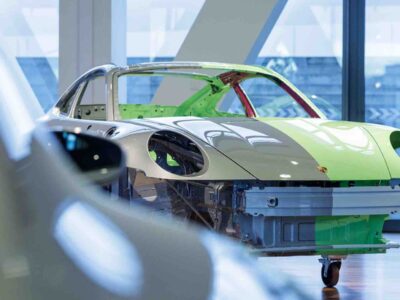Unless you live in southeastern Alaska, you might not be familiar with Tok. It’s a town of about 1,300 residents located 200 miles from Fairbanks, maybe best known for its proximity to the Mentasta Mountains, and the bears, moose, wolves, lynx, coyotes, and other wild animals that roam nearby. But Tok has also gotten recent attention for something else: becoming a trailblazer in the state as the first town in Alaska to use an electric school bus.

Last fall, privately held Tok Transportation acquired the bus using a grant from the Alaskan Energy Authority (AEA). The electric model replaces one of seven diesel buses in the town’s fleet. It was manufactured by Thomas Built Buses, a High Point, N.C.-based maker of electric and diesel-powered buses. The electric bus has a range of about 135 miles on a single charge.
Electric buses carry a pretty high price tag – typically between $350,000 and $400,000 – but Tok Transportation’s owner, Gerald “Stretch” Blackard, figures the bus will be a good investment over the long term thanks to lower fuel and maintenance costs. According to industry estimates, it costs about 19 cents a mile to run an electric bus vs. 54 cents a mile for the average diesel bus.
Blackard, who owns Tok Transportation with his wife, Sara, bought the electric bus with nearly $400,000 in grant money as well as $50,000 of his own cash. Part of the money was used to buy a solar-powered battery-recharging system. Blackard was motivated by his own curiosity over how well electric vehicles (EVs) and renewable energy might work in a cold climate.
“For me, the interest is in the technology and what it can produce,” he said in an interview with Alaska Public Media. “And I like being one that can help in the process of making things more available to other places.”
Tok Transportation carries students to four area schools. Blackard had already spent a couple of years researching electric buses before learning about an AEA program that aims to encourage school districts to invest in buses that produce lower emissions. The program is funded by Alaska’s share of a settlement with Volkswagen after the German automaker admitted falsifying its vehicles’ emissions ratings.
Seven Alaska school districts used program grants to buy cleaner-burning diesel-powered school buses. Tok’s Alaska Gateway School District was the only one to acquire an electric bus. One reason school officials in Tok supported the idea was because it complements the district’s other renewable-energy projects, including the Tok School’s biomass-fueled heat and power plant.
“Having the first electric bus in Alaska is really exciting, and it fits right in with what Tok and the Alaska Gateway School District have been doing with alternative energy,” Tok School Superintendent Scott MacManus told Alaska Public Media. “And, you know, it’s the direction that the world needs to be moving in.”
The Alaska Energy Authority was initially hesitant to go along with Blackard’s proposal because the bus would have to be recharged with power from the local utility, which generates electricity with diesel-fired generators.
“The concern was that I was going to be swapping one diesel-burner for another diesel-burner,” Blackard said. “So, as part of the grant, they required me to do something to offset that part of it. That’s where the solar came in.”
The solar-powered battery charger worked pretty well during the first month, Blackard said. In fact, it generated most of the power needed to recharge the bus’s batteries. But as sunlight became increasingly scarce, more power had to be provided by the local grid. During the winter, the sun isn’t out very long in Alaska.
To help overcome that challenge, Blackard said he plans to invest in a system that will use a bank of batteries to store solar energy collected during the day, and then use it to recharge the bus’s batteries. For now, his goal is to see how well the bus operates during the coldest months.
The bus worked “better than expected” during a couple of days when temperatures dipped to 35 degrees below zero, Blackard said. He cited a couple of reasons for this. One, he insulated the battery compartment. And two, he parked the bus in a warm garage before and after it was in operation.
Tok could be on the front lines of a broader movement to install more electric school buses across the U.S. Leading the charge has been the state of Virginia, which in 2019 partnered with Dominion Energy to buy at least 1,050 V2G electric school buses over the next five years.
A movement toward more electric school buses should bode well for Thomas Built Buses, a subsidiary of Daimler Trucks North America LLC. The company notes on its website that its Saf-T-Liner C2 Jouley electric bus has a number of advantages over diesel-powered buses. The electric bus not only runs free of emissions, but also reduces noise pollution and doesn’t need fossil fuels. It can drive up to 65 miles per hour and accelerates from zero to 60 in 45 seconds.





